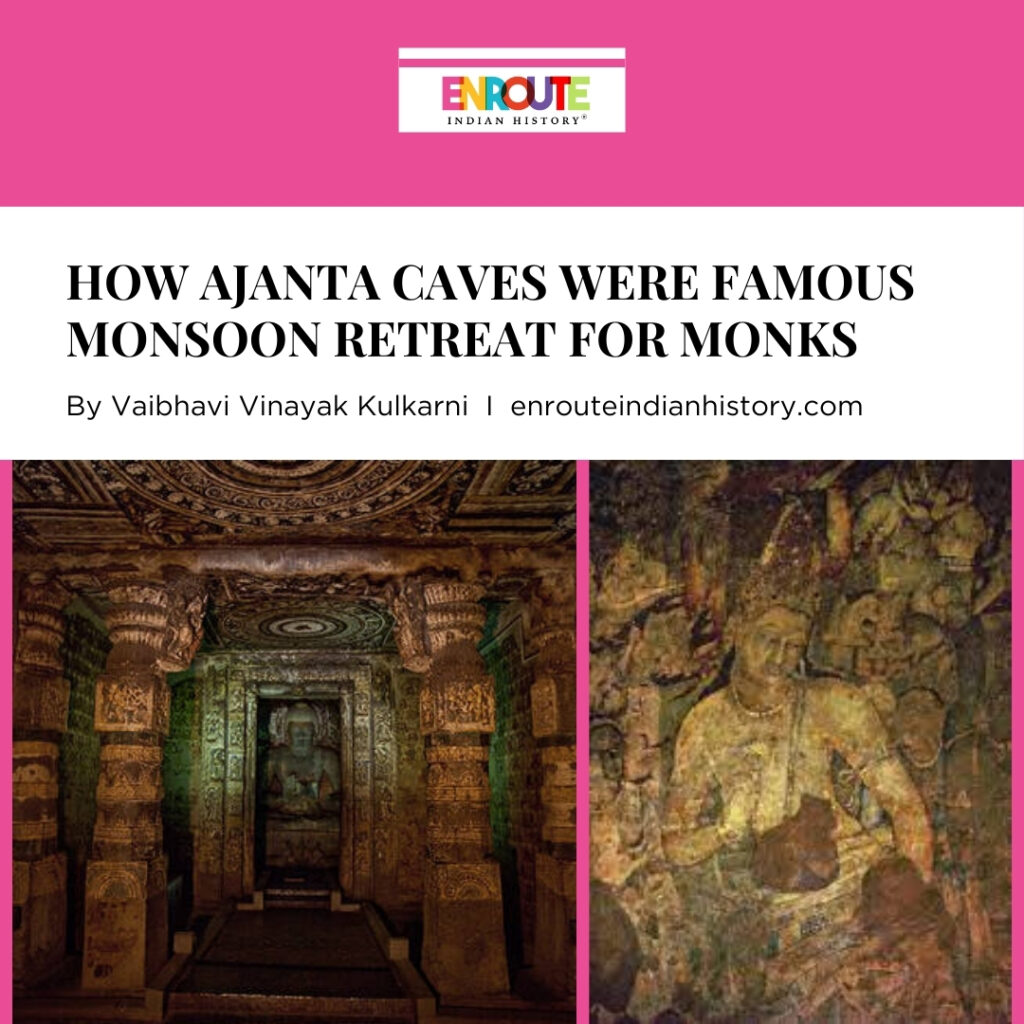
It’s the 5th Century CE. In Ajanta, the air is filled with the sounds of chisels striking stones and the gentle murmur of monks chanting in meditation. Artists are meticulously sculpting grand statues of the Buddha and intricate reliefs that depict the life and teachings of the Enlightened One. Painters, with their vibrant palettes, are carefully applying colors to murals that tell the ancient Jataka tales, stories of the Buddha’s previous lives. The caves are alive with activity, as craftsmen focus on the minutest details, creating some of the most beautiful and enduring art and architecture of ancient India.
The grandeur of Ajanta Caves is palpable. Each cave is a hive of artistic and religious devotion, where the harmony between human skill and spiritual dedication is perfectly expressed in stone and pigment. Visitors from far and wide are drawn to these magnificent caves, marveling at their beauty and the stories they tell.
But amidst this splendor, only few might wonder about the origins of this incredible cave architecture. How did these simple shelters evolve into the masterpieces we see today?
Maharashtra is home to some of the most remarkable examples of cave architecture in India. The origins of Cave Architecture in Maharashtra lie in something as humble as monsoon retreats for Buddhist monks and traders. The tradition of “varsavasa,” or the monsoon retreat, played a significant role in the development of these caves, leading to the creation of masterpieces like the Ajanta Caves.

Ajanta Cave Sculpture of Buddha (Sourse: UNESCO)

Map of Buddhist Caves in Western Deccan, India (Source: Pia Brancaccio)
The Concept of Varsavasa
Varsavasa is a term in Buddhism that refers to the monsoon retreat, a period when monks would stay in one place during the rainy season. This practice was essential for several reasons. During the heavy rains, traveling wasdifficult and could harm the monks’ health. Staying in one place allowed them to meditate, study, and perform religious activities without the disruptions caused by the monsoon. Initially, monks sought shelter wherever they could find it, such as under trees, in forests, or in simple natural caves.
However, as the Buddhist community grew, there was a need for more permanent and comfortable retreats. This led to the construction of viharas (monasteries) and chaityas (worship halls) in caves. These structures provided monks with a place to live, meditate, and conduct religious ceremonies during the monsoon. The practice of varsavasa became a key aspect of Buddhist monastic life, influencing the architecture and layout of their retreats.
Early Cave Architecture in Maharashtra
The earliest rock-cut caves in Maharashtra date back to around the 2nd century BCE, primarily serving as monsoon retreats in Maharashtra for Buddhist monks, offering them shelter during the heavy rains. These early Buddhist caves in Maharashtra laid the foundation for more elaborate structures over time. The Sahyadri mountain range, also known as the Western Ghats, played a crucial role in the development of these Buddhist monsoon retreats. The mountain range provided not only the physical rock faces necessary for creating the caves but also natural passes that facilitated trade and travel. These passes, such as the Naneghat and Bhorghat, became critical points of convergence for trade routes and, consequently, for the establishment of monastic sites. The Bhaja and Karle caves, for instance, were situated along significant commercial paths that connected northern and southern India as well as the coast to the Deccan plateau. This strategic placement ensured that the caves were accessible to monks and traders-merchants.
During the rainy season, the caves offered shelter to monks, travelers, and traders, protecting them from the incessant downpours and allowing them to continue their activities in a dry, secure environment. Cave retreats during monsoon, like these, have been utilized for a variety of purposes, including meditation, shelter, art, burial, and religious ceremonies, according to ancient ruins and historical records. The monsoon’s influence on the region’s lifestyle and architecture highlights the practical and spiritual significance of these rock-cut sanctuaries.
The construction of these early caves, which are part of Maharashtra’s ancient cave architecture, was often a collaborative effort between the monastic community and wealthy patrons, including traders and local rulers. This symbiotic relationship between the monks and their patrons played a significant role in the evolution of Varsavasa cave architecture. Initially, the caves were quite plain and functional, focusing on creating a space that could provide shelter and meet the basic needs of the monks. Over time, however, as more resources became available, the architectural style evolved. The introduction of pillars, arches, and intricate carvings marked the beginning of a more sophisticated approach to cave construction.

Bhaja Caves (Source: Google Photos)

Pandavleni or Tri-rashmi Caves, Nashik (Source: Google Photos)
The Ajanta Caves: A Culmination of Mastery
The Ajanta Caves, a UNESCO World Heritage Site, represent the pinnacle of Buddhist cave architecture in Maharashtra and are a testament to the artistic and architectural prowess of ancient India. It is situated above the gorge of the meandering Waghora River, in the western part of Maharashtra. These 30 rock-cut caves were excavated in two significant phases between the 2nd century BCE and the 6th century CE. The caves’ locations were strategically chosen not only for their natural beauty but also for their proximity to important trade routes, which facilitated the influx of resources and patrons.

Overview of Ajanta Caves (Source: UNESCO)
Ajanta is renowned for its exquisite mural paintings and detailed sculptures. The walls and ceilings are adorned with scenes from the life of the Buddha, as well as depictions of everyday life, showcasing the multicultural and prosperous society of the time. The architectural elements, such as intricately carved columns and reliefs, highlight the artistic prowess and devotion of the craftsmen. These paintings and sculptures, executed with a high level of skill and creativity, are considered some of the finest examples of ancient Indian art.
The construction of the Ajanta Caves can be divided into two main periods: the earlier phase (2nd century BCE to 1st century CE) and the later phase (5th to 6th century CE). During the earlier phase, the caves were relatively simple and included primarily Viharas (monasteries) and Chaityas (worship halls). Caves 9, 10, 12, 13, and 15A belong to the earlier group of caves. The murals in these caves depict stories from the Jatakas, which are tales of the Buddha’s previous lives. These early caves reflect the patronage of the Hindu Satavahana dynasty (230 BCE – 220 CE) and their artistic influence. The second phase, particularly during the reign of the Vakataka king Harisena, marked a period of renewed architectural and sculptural fervor. This later phase witnessed the construction of some of the most elaborate and artistically significant caves, marking the height of Ajanta’s development. Twenty-two new caves were added to the pre-existing nucleus, showcasing a dramatic increase in both scale and ornamentation. This period saw the creation of richly decorated caves with elaborate pillars, brackets, door jambs, shrines, and facades. The walls were embellished with exquisite mural paintings executed in tempera technique, portraying a vibrant and multicultural society.

Ajanta Cave Painting (Source: Google Photos)
The presence of foreign products and influences in these artworks suggests active trade links with the Indian Ocean during this time. While clearing the banks of the Waghora River in 1999–2000, the Archaeological Survey of India stumbled upon the remnants of a brick-built monastery. Among the findings was a gold coin issued by the Roman Emperor Theodosius II, indicating that fifth-century foreign trade contributed to the growth and prosperity of the Buddhist site. This discovery underscores Ajanta’s role as a thriving hub of cultural and economic exchange.The Ajanta Caves were rediscovered by a British tiger-hunting party in 1819.

Mahajanaka Jataka Painting from Ajanta (Source: Map Academy)

Chaitya Cave at Ajanta (Source: Google Photos)
The Ajanta Caves, with their grandeur and artistic excellence, are the culmination of Cave Architecture in Maharashtra. These Monsoon Retreats in Maharashtra stand as one of the greatest achievements in ancient Buddhist rock-cut architecture, offering a rare glimpse into the rich tapestry of the socio-cultural, religious, and political history of India. These historical caves in Maharashtra, nestled in the Sahyadri Mountains evolved from simple monsoon retreats for monks into monumental masterpieces of religious art and architecture. The concept of Varsavasa, where monks would reside during the rainy season, is vividly manifested in these caves, making them an ideal destination for exploring Maharashtra’s ancient cave architecture. Ajanta, with its intricately carved sculptures and exquisite murals, showcases the evolution of cave retreats from simple shelters to grandiose centers of Buddhist activity. The collaboration between monks, artisans, and patrons over several centuries created a legacy that continues to inspire awe and admiration to this day. Today, these caves not only serve as a testament to historical and religious significance but also make for a perfect monsoon gateway, offering a serene and enriching experience amidst the lush greenery and the sound of monsoon rains.
Bibliography:
- Dr. Preeti Oza. Buddhism and Spread of Religion through the Inner Nuances of Caves – A case study of Western India. Researchgate
- Kathleen D. Morrison (1995) Trade, urbanism, and agricultural expansion: Buddhist monastic institutions and the state in the Early Historic western Deccan, World Archaeology, 27:2, 203-221.
- Pia Brancaccio. The Buddhist Caves in Western Deccan, India, between the Fifth and Sixth Centuries. Hualin International Journal of Buddhist Studies, 1.2 (2018): 1–13
- https://whc.unesco.org/en/list/242/
- Buddhist caves in Maharashtra
- Buddhist monsoon retreats
- Cave retreats during monsoon
- Exploring Maharashtra's caves in monsoon
- Historical caves in Maharashtra
- Maharashtra's ancient cave architecture
- Monsoon retreats in Maharashtra
- Monsoon tourism in Maharashtra
- Monsoon travel destinations in India
- Varsavasa cave architecture


















